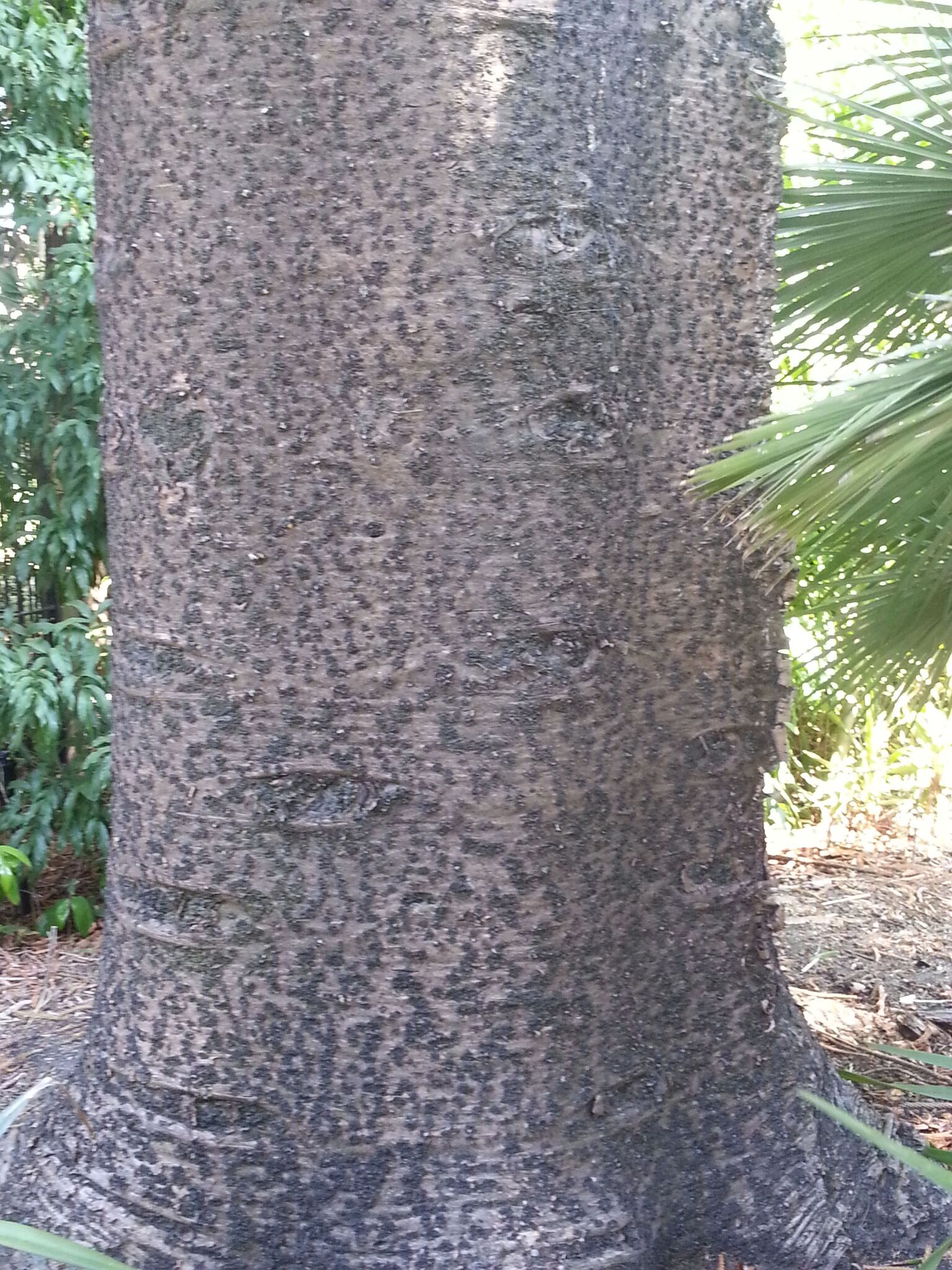
A conical tree growing to about 30 m or so tall but becoming narrow and almost columnar with age. Bark grey-black, flaking, deep pink beneath. Branches horizontal in whorls of 4-7. Young trees with symmetrical comb-like branches producing a highly formal architecture but becoming narrower and irregular with age. Juvenile leaves (generally those found on the lower branches) narrow, incurved, up to 1 cm long. Adult leaves smaller, ovate and and overlapping. Male cones to 5-6 cm long at the tips of the branchlets and similar in width, autumn or Sept.-Oct. Female cones generally formed in small numbers in the uppermost branches, upright on the main branch axis, dorsiventrally flattened, 7-10 cm long, 9-12 cm wide with each scale having a spine about 1 cm long, formed mostly Sept.-Nov; seed winged. (Syn. Araucaria excelsa (Lam.) R. Br.
This is the most widely grown of the araucarias, being cultivated widely in the Mediterranean, Azores, South Africa, New Zealand, Tasmania and elsewhere. In Australia it has been a major signature tree planting of coastal townships from the earliest days of settlement, stamping them with much of their character. Trees were probably originally planted on the coast as landmarks for shipping. Large, natural specimens on Norfolk Island are estimated at over 350 years old with a circumference of over 11 m.
Norfolk Island.
Comb-like branchlets. Old trees become rather narrow, losing their basic conical shape to become similar to A. columnaris but broader and with the comb-like branches persisting towards the tip.
SA: Beaumont (1 Dashwood Rd. Probably ptd by John Fullerton Cleland in late 1800s in grounds of original homestead built c. 1839 and occupied by descendants); Brighton (2 trees known locally as Paddy and Charlie, ptd between 1850 &1880, now at entrance to Kingston Caravan Park); Kangaroo Island, Penneshaw (esplanade adjacent to Frenchman's Rock, 10 trees ptd 1936 by children of pioneering families); Langhorne Ck (ptd over 100 yrs ago at 'Fairholme', known as Folletts Pine Tree); Marryatville (Eden Park Conference Centre, 1 The Crescent. Ptd in garden of first settler George Brunskill in 1840); Mt Gambier (Vansittart Park); Nelson; Normanville (ptd c. 1924 and now decorated each Christmas by Electricity Trust and known locally as the Christmas Tree); North Adelaide (Lincoln College, Ward St); Port Macdonald; Victor Harbour (Soldiers' Memorial Gds, foreshore, each commemorating a fallen soldier of the World War I); Penola (Yallum Park); West Torrens (Novar Gardens). NSW: Botany Bay (about 100 trees along the waterfront); Centennial Park; Gerringong (Belinda St, an avenue of trees); Gladesville (Gladesville Hospital outside Digby House); Jervis Bay (Bot. Gds); Manly (Foreshore); Sydney (Royal Bot. Gds); Woollahra (Council Chambers 27 m in 1992 100 years old ). VIC: Ballarat (near E Oval); Churchill Island (Homestead ptd 1872, possibly donated to the garden by Ferdinand von Mueller); Malvern (Public Gardens); Melbourne (Royal Bot. Gds, inside 'F' Gate a pair defining old entrance were planted by W.R. Guilfoyle in 1875 at which time they were 6 m tall - in 1893 visiting London nurseryman James Veitch described them as 'tall specimens'); Portland (coastal avenue); Port Fairy (coastal avenue); Sth Melbourne (St Vincent Gds); Warrnambool (coastal avenue). ACT: Australian National Bot. Gds. TAS: Burnie (St George's Anglican Church c. 80 years old also prominent landscape feature); Devonport; Franklin; Hobart (Government House; Newtown planting celebrating end of Crimean War; 'Runnymede'; Royal Tasmanian Bot. Gds); Port Arthur (Main Road, an avenue 87 years old in 1989; off Wharf Road ptd by local dignitaries and c. 70 years old in 1989); Stanley (memorial row and avenue in cemetery. Many early settlers in Tasmania were from Norfolk Island and are known to have planted trees at their front doors).
Source: (1995). Araucariaceae. In: . Horticultural Flora of South-eastern Australia. Volume 1, Ferns, conifers & their allies. The identification of garden and cultivated plants. University of New South Wales Press.
